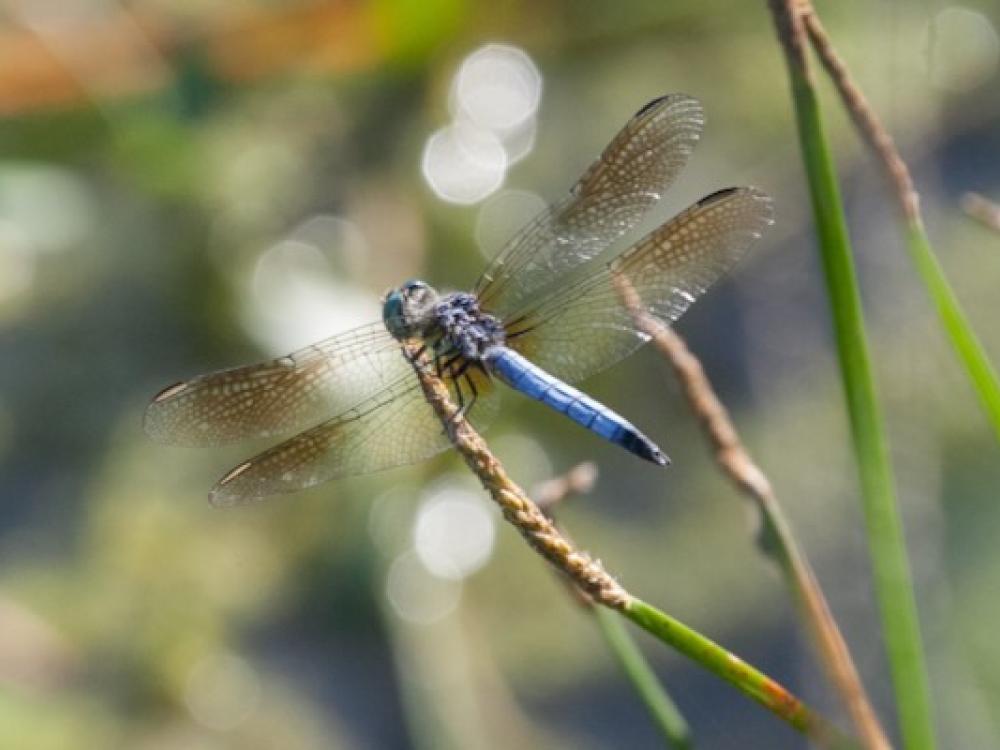
Dragonflies, like this blue dasher in the skimmer family, can eat hundreds of mosquitos per day. Photo by Brent Franklin.
Sept. 1, 2023
On a recent hot day — a break from an even hotter month — I visited a pond at Sheri Capehart Nature Preserve in Arlington.
Above the shrinking water source, dozens of dragonflies put on an aerial show: dipping and soaring, circling and hovering, chasing, courting, mating and skimming the water’s surface for egg-laying. The brilliant sun glinted off their cellophane-like wings. Some perched on tall reeds. The rest zipped around, performing in-flight acrobatics — tricks that human aviators might mimic but never equal.
Dragonflies live on every continent except Antarctica. The best place to find them is around water, where they spend most of their lifecycle. According to International Union for Conservation of Nature, the destruction of wetlands is among the top causes for their decline worldwide.
North Texans should want to keep them around, not only for their beauty. They are nature's natural pest control. Dragonflies can consume hundreds of mosquitos per day.
According to Sam Kieschnick, DFW-based wildlife biologist for the Texas Parks and Wildlife Department, dragonflies are abundant in DFW when it gets hot — late spring through early fall. Some species, like the meadowhawks, can be seen nearly year-round. Others, like the wandering glider and common green darner, migrate, he said.
"They can migrate really long distances — and in the case of common green darners, over several generations. Other dragonflies overwinter in the nymph/naiad stage in the water."
What else do we know about these freewheeling and fierce pest-eating fliers?
DRAGONS VS DAMSELS
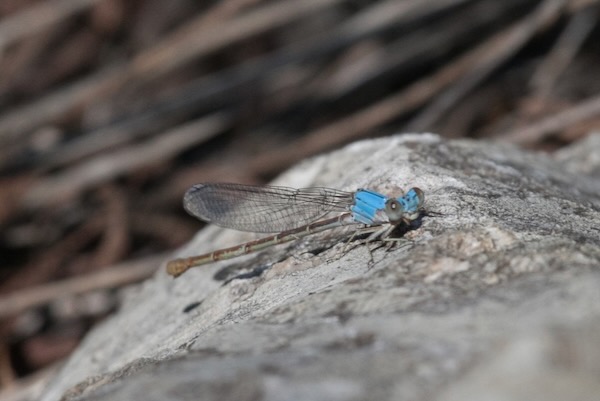 A damselfly with a lovely name: "powdered dancer.” Photo by Brent Franklin.
A damselfly with a lovely name: "powdered dancer.” Photo by Brent Franklin.
Neither dragon nor fly, dragonflies are a varied and colorful group of flying insects within the order Odonata. Within that order there are dragonflies and also damselflies. Those names might take our imaginations to medieval stories with castles and knights.
The common names for dragonflies are incredibly creative and imaginative. There are pondhawks, widow skimmers, Halloween pennants, blue dashers.
When it comes to damselflies, there’s also ebony jewelwings, bluets and others.
Dragonflies are different from damselflies. There are a few ways to tell them apart.
Typically larger than damselflies, dragonflies rest with wings held out and flat, while the smaller damselflies rest with wings folded (with a few exceptions). Dragonflies have huge wrap-around eyes that look like goggles, while damselflies have small, bead-like eyes, set far out on the sides of their heads. In flight, dragonflies are masters of the skies, while damselflies flutter.
WHEEL LIKE A HEART
Male dragonflies may defend an area where they hope to find suitable females, with threat displays and even attempts to bite at male competitors. It is likely that some of the acrobatic swoops and dives I saw at the preserve were territorial males.
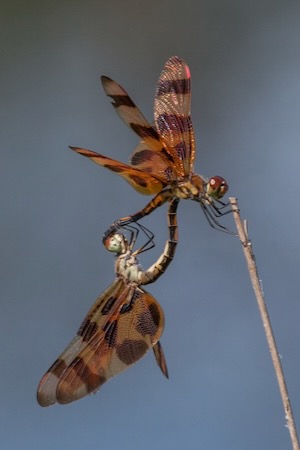 These Halloween pennants connect in a heart-shaped “wheel” position during mating. Photo by Brent Franklin.
These Halloween pennants connect in a heart-shaped “wheel” position during mating. Photo by Brent Franklin.
When a female comes into the area, the male uses the end of his abdomen to clasp her right behind the head and the two may fly in tandem. If she is receptive, she bends her abdomen up to connect with the male’s body just behind the thorax (the middle segment of the body, where wings and legs are attached). This mating position is called the “wheel position” but really resembles a heart.
Making a heart shape sounds romantic, but by our standards there is not much romance. The male’s sexual structures are made such that he can attempt to scoop out any sperm left by a competitor.
There is at least one European species, according to Cindy Crosby’s delightful book, Chasing Dragonflies, in which females may feign death in order to avoid aggressive males. We have to remember that in some species, sex may not involve the emotions and relationships that are so important in humans.
After mating, the female lays eggs, sometimes with the male watching over or still attached behind her head and flying in tandem. For many dragonfly species, females dip the end of their abdomen into the water, releasing some eggs each time she does so.
POND GOBLIN
The dragonfly’s story begins in the water when eggs hatch into drab-colored aquatic nymphs.
They are fierce predators of small insects and just about any small animal that they can catch — even tiny fish. A nymph might live as this underwater creature, a sort of goblin of the pond, for months or even years. After transforming into the air-breathing, flying form that we recognize, its life may be measured in weeks or at most, months.
 A typical dragonfly nymph netted from a pond at Sheri Capehart Nature Preserve in Arlington. Photo by Michael Smith.
A typical dragonfly nymph netted from a pond at Sheri Capehart Nature Preserve in Arlington. Photo by Michael Smith.
The dragonfly nymph can use its six legs to clamber over obstacles along the bottom of a creek or pond. But it has another way of moving when it needs a burst of speed to catch prey. As described in Chasing Dragonflies, this involves “expanding and contracting its rectum internally” to force water out of the orifice and propel the nymph forward. (Natural history is always interesting but not necessarily beautiful.)
What about feeding? The nymph’s lower jaw can shoot forward like the inner jaws of the creature in the Alien movies, with hooks and teeth to grab an unsuspecting meal. For mosquito larvae and other prey, the end is sudden and unexpected.
TAKING FLIGHT
After the nymph grows and periodically sheds its exoskeleton, it is ready to make the transition to life above the water. It emerges from its exoskeleton one last time and climbs onto something — a rock or perhaps a reed above the water — and expands its wings and waits for them to harden.
Cindy Crosby talks about this being “one of the most vulnerable times in a damselfly’s or dragonfly’s life.” Birds, frogs and other predators can easily pick them off as they get ready to fly.
And oh, can they fly!
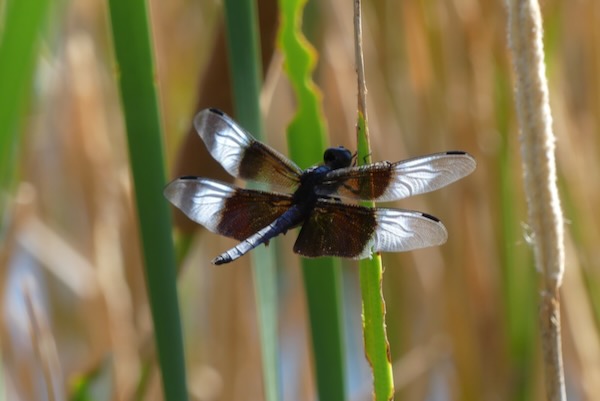 A male widow skimmer is one of the common dragonflies found at Sheri Capehart Nature Preserve in Arlington. Photo by Michael Smith.
A male widow skimmer is one of the common dragonflies found at Sheri Capehart Nature Preserve in Arlington. Photo by Michael Smith.
“I always tell people, if you want to learn patience, try to photograph dragonflies in flight.” That’s what local dragonfly expert Brent Franklin told me. Dragonflies (as opposed to damselflies) can move each wing independently so that they can hover, dart down or up, and even fly backward.
And they can change between those flight maneuvers in a heartbeat.
Franklin started out as a birder before noticing all the beautiful and interesting dragonflies and damselflies in our area. Using the citizen-science app iNaturalist, observers have seen 81 dragonfly species and 34 damselfly species in the DFW area between Weatherford and Rockwall, Denton to Midlothian.
And Franklin said that most of these species show pattern and color differences between males and females. There’s a lot to see.
Dragonflies eat lots of mosquitoes, but they “will eat anything that flies, including each other,” according to Franklin. There are limits, of course, because some things are too large. The bats and birds can breathe a sigh of relief (between mouthfuls of dragonfly, as some birds eat dragonflies).
FINDING DRAGONFLIES
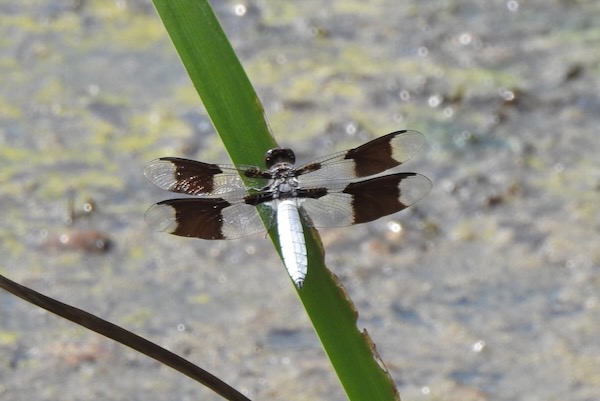 A common whitetail dragonfly. Photo by Michael Smith.
A common whitetail dragonfly. Photo by Michael Smith.
I asked Brent Franklin how he looks for dragonflies. He said sometimes he wanders and other times he sits quietly and waits for the dragonflies to come to him.
“The easy ones, the low-lying fruit, are the pond dragonflies — all you have to do is wander around the pond and you’re gonna see a lot of species.”
Some dragonflies and damselflies have particular habitats where they are found.
“Other than ponds, you need to visit streams, both fast-flowing and slow-flowing. You're not going to find an American rubyspot (damselfly) unless you’re at a stream.”
Franklin suggested a couple of books that he has found to be essential Texas field guides: Dragonflies of Texas and Damselflies of Texas, both by John Abbott.
DRAGONFLIES IN STORIES AND CULTURES
 Neon skimmers practically glow in sunlight. Photo by Brent Franklin.
Neon skimmers practically glow in sunlight. Photo by Brent Franklin.
In some Native American mythology, the dragonfly is associated with water, health, swiftness and transition. (Perhaps based on observation of the life of a dragonfly starting in water followed by a dramatic change to an insect with amazing flight).
In Japan, dragonflies represent strength and courage as well as happiness and success. In contrast, European folk tales show the dragonfly as the companion of snakes, perhaps able to stitch up their injuries. In England, one name for the insect was “the devil’s darning needle.” In the U.S., some believed that dragonflies could stitch a bad person’s mouth shut or sew his fingers together.
WHAT IS IN THE FUTURE FOR DRAGONFLIES?
These insects have been on Earth in one form or another for at least 250 million years, and that ought to count for something.
“I would suggest that dragonflies are tough critters” said Cindy Crosby, considering their long track record of survival. “However, habitat destruction and climate change will likely affect their numbers and the number of species in the future — that's my opinion.”
It's an opinion shared by others. The International Union for Conservation of Nature, which monitors the conservation status of living things, commented on how dragonflies and damselflies are doing. Their website says “…that 16 percent out of 6,016 species are at risk of extinction, as their freshwater breeding grounds increasingly deteriorate.” They went on to say that “pesticides, other pollutants and climate change are growing threats to species in every region of the world….”
Next time we watch the dance of dragonflies, we can be reminded of how we need to preserve wetlands and help keep that 250-million-year lineage of dragonflies going.
Stay up to date on everything green in North Texas, including the latest news and events! Sign up for the weekly Green Source DFW Newsletter! Follow us on Facebook,Twitter and Instagram. Also check out our new podcast The Texas Green Report, available on your favorite podcast app.









